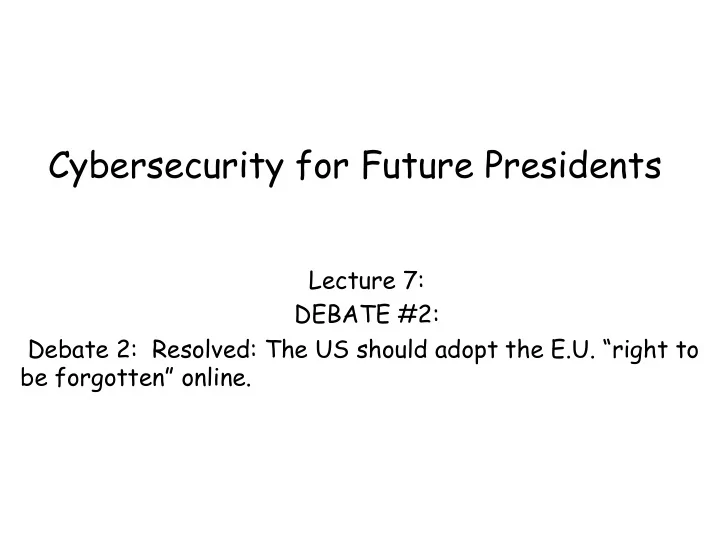

Cybersecurity for Future Presidents Lecture 7: DEBATE #2: Debate 2: Resolved: The US should adopt the E.U. “right to be forgotten” online.
My office hours: Any Questions? Wed. afternoon, 12-3pm, 442 RH. Signup sheet • About previous lecture? circulating • About homework? (debate questions) • About reading? (D is for Digital Chapters 3, 11; debate articles and videos) Midterm this Friday! Reading for next week (after midterm): D is for Digital, Part III, Communications, introduction and Chapter 8, pp. 117-134. Exercises: based on the reading. Next Debate (in 2 weeks): Resolved: The U.S. Election Assistance Commission should promote internet voting for public elections on a model similar to Estonia. Debate teams please sign up to see me this week or next week.
Cybersecurity events from the past week of interest to future (or current) Presidents: While you were out… • U.S. DoJ readies indictment of 5 Iranian hackers for 2013 attempt to control Rye NY flood control dam • $81M theft from New York Fed via malware on Bangladeshi computers – stolen credentials. Further transactions caught via human detection of spelling error • South Korea energy, transportation, other infrastructure industries hit by “OnionDog” attacks over past 2 years • Apple – FBI dispute continues to simmer in public press • Dept of Justice said to be eyeing similar action against WhatsApp (encrypted messaging) • Happy Madison’s Birthday! Author of Bill of Rights. Coming up: … ?
Today’s Debate Topic Debate 2: Resolved: The US should adopt the E.U. “right to be forgotten” online.
What we’ve covered so far - Readings :Texts: • Kernighan, D is for Digital: Preface, Chapters 1-3 and 10-11 • Anderson, Security Engineering: Chapter 1, pages 3-15 Other • Clark, Berson, Lin, At the Nexus of Cybersecurity and Public Policy: Tensions between cybersecurity and other public poicy concerns, pp. 93-115. • Abelson et al: Keys Under Doormats • Landau, Making Sense of Snowden • Vance, Report on Smartphone Encryption and Public Safety • US-CERT, Understanding Web Site Certificates • EU factsheet on the Right to be Forgotten • Toobin, “The Solace of Oblivion”
What we’ve covered so far, Lectures Technology topics • Cybersecurity terms and issues, Digital vs. Analog, Information vs. Data, data representation, bit manipulation • Basic computer architecture • Basic Telephony (circuit switching vs packet switching) • Cryptography history and technology, bit operations symmetric vs asymmetric crypto • Cybersecurity fundamentals: system security, access control, C.I.A. properties, Policy, Mechanism, Assurance, Incentives • Cyberattacks: DoS/DDoS, Attacks via inputs (B.O.), Supply Chain, Side Channels, Social Aspects Policy topics • US Government Structure • Search and surveillance history, legislation, court cases • Cryptography policy and legislation • Privacy Fundamentals: FIPPs, U.S. vs. E.U. policy approaches; Safe harbour, Right to be forgotten CriticalThinking: Debates #1 and #2
Another way to understand buffer overflow attacks, if you use the web: • Imagine you click a hyperlink on a web page. • Your browser knows the page you are currently on and saves its location so when you press “Back” you can return there. – Your browser translates the first part of the URL to an IP address via DNS – Sends request to the IP address and retrieves a page, which may include Javascript programs that execute within your browser – Suppose that Javascript overwrites the place where your browser saved your “Back” address with some other page. – Now you press the “Back” button and you end up on some other page entirely • This is similar to what happens in the buffer overflow attack: you end up executing a program (vs. viewing a web page) that is other than what you intended.
Yet Another way to think about what happens in a buffer overflow, if you enjoy cooking • Suppose you are cooking something from a recipe with several sub-parts • You start following the directions, setting a bookmark each time you go to a different page so you can find where to return Page 131: 1. To make a papillote: Page 471: Page 653: Brownies … Chicken Supreme Papillote 1. Melt ½ C. butter and 4 oz. <return> 1. Preheat oven to 400 0 F. chocolate, and let cool. 2. Prepare: Breast of Chicken, 2. Beat 4 eggs with ½ tsp. allowing it to cook until ½ done. salt. Page 339: Colbert Butter Place it on a parchment heart for 3. Add 2 C. sugar and 1 tsp. 1. Cream together ¼ cup Papillote, � page 131. vanilla Maitre d’Hotel Butter, ½ 3. Before folding, place: 1 Tablespoon 4. Combine chocolate, eggs, tsp. melted beef extract, Colbert Butter, � page 339, on and sugar. ¼ tsp. chopped tarragon each ½ breast. Seal the paper and X 5. Fold in 1 C. sifted flour Reset return bookmark to • bake on a baking sheet for about and stir in 1 C. pecans page 653, Brownies 15 minutes. 6. Bake in 9” x 13” pan at <return> 4. Serve with: Pilaf, � p. 183 350 0 F. about 25 minutes. <end> <end>
What is yet to come … • Accountability, including identification, authentication, forensics • History of computer security policy/economics • Elections and cybersecurity • Genomics and cybersecurity • Digital currency technology and policy • Issues for future presidents
Rubric for Debaters
Recommend
More recommend